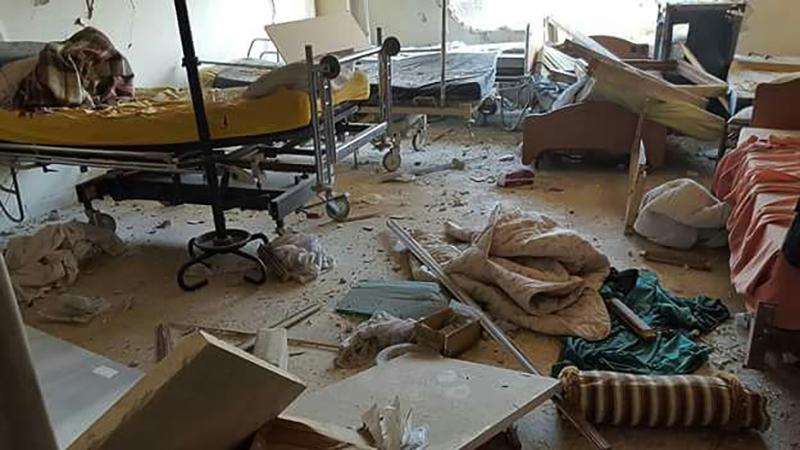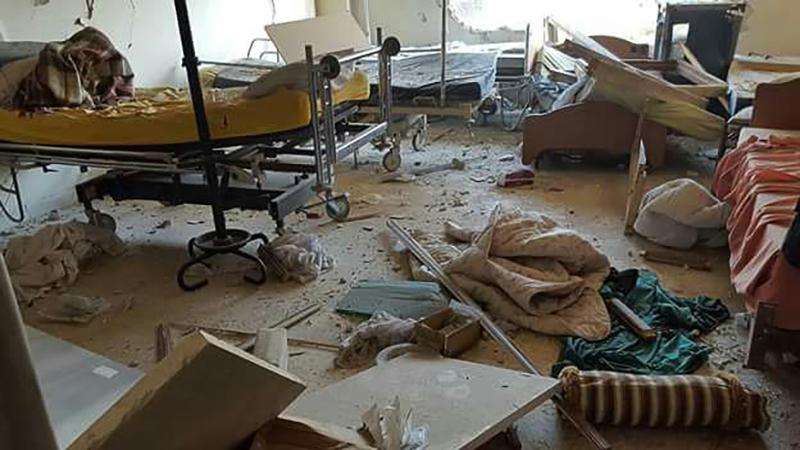Latest Update: MSF Sends Medical Supplies for Wounded People Evacuated From East Aleppo
The airstrikes came just minutes apart on the morning of February 15, 2016, shattering a large hospital supported by Doctors Without Borders/Médecins Sans Frontières (MSF) in Syria’s Idlib Province. It was a "double tap" attack in which the pilots circled back after dropping thier initial payload to drop more bombs on the people who responded to the first attack. All told, 25 people were killed, including five children. Among the adult fatalities were a doctor, a chief nurse, five nurses, and a lab technician. The raids were carried out by forces loyal to the Syrian government.
"Some of the victims were patients lying in their hospital beds, others were visiting their relatives," recalled Dr. Mazen, a 55-year-old orthopedic surgeon who worked at the hospital until it was destroyed. "Our hospital was reduced to rubble, and so was my heart."
Dr. Mazen still thinks back to the attack every day. "The only reason I have survived was because I was 15 minutes late to work," he said. "I should have been there at 9:00 a.m. The first strike came at 9:02 a.m. Rescue teams started to move in to try to pull survivors out from under the rubble. But the next strike came at 9:05 a.m. And then again at 9:45 a.m and 9:50 a.m."
As all hell broke loose, the surgeon rushed along with volunteer rescuers to evacuate the survivors they could find to the nearest medical facility—the Central Hospital in the northwestern Syrian town of Maaret al-Numan. But the nightmare was not over. "Syrian air forces then fired two missiles at the Central Hospital, one at 11:00 a.m, the other at 11:05 a.m," Dr. Mazen recalled.
"The Most Dangerous Places"
Scores of hospitals and medical facilities have been damaged or destroyed—mostly by airstrikes—since the Syrian war broke out in 2011. As a result, hundreds of thousands of people have been left without access to adequate health care. In addition, hundreds of doctors and other medical professionals have been killed, with many others detained and tortured for daring to provide care to people in "enemy" territory.
Thousands of health workers have joined the human tide of refugees fleeing Syria in recent years, knowing that they might otherwise become the next targets. Some, however, have stayed behind, fearing that if they left too, injured or sick civilians still trapped in the country would have no chance at life. But because of the staff shortages, doctors still working in Syria face an enormous workload.
More from Syria: Inside an East Aleppo Hospital
"There are days when we have to treat more than 100 people at once—we see patients lying on the floor screaming in pain, but we just can’t get to everyone fast enough," said Dr. Ahmad, another surgeon who works at an MSF-supported hospital near the town of Jisr al-Shughour, not far from the Turkish border.
"We have faced incredibly difficult days. It is as though Syrian air forces and those of its allies are seeking to maximize the number of civilian casualties; this is clear when markets, bakeries, town squares, and hospitals are hit. In Syria, the most dangerous places to be are a hospital or an ambulance."
Under international humanitarian law, hospitals and ambulances should enjoy a special protected status. In Syria, however, health workers have had to go to great lengths in order to conceal their ambulances and medical facilities, because they know that clear markings make them prime targets for attack.
"We hide our hospitals and cover our ambulances with mud in order to disguise them," said Dr. Ahmad, a general surgeon trained at Aleppo University. "The building housing [the hospital where I work] used to be a cheese factory, but we turned it into a fully functioning hospital. Working conditions are not ideal but we are trying our best."
Others have set up medical facilities in abandoned poultry farms or empty school buildings. "We doctors have learned that we cannot work in clearly marked normal hospital buildings in Syria any more," said Dr. Ahmad. "It’s just too dangerous. Any building that looks like a hospital will be targeted.
"Of course," he continued, "this means that our patients aren’t getting the quality care they need, because these buildings were not designed to be hospitals. We also lack a lot of essential equipment."
Still, many of Dr. Ahmad’s patients would simply not survive if they had to wait to wait to be transported across the border to Turkey. The border is mainly closed, and for some—particularly those with war injuries—the journey would just be too long.
Despite the grim working conditions he and his colleagues face, Dr. Ahmad believes he must remain in Syria. "We will never leave," he said.
Moving Hospitals and Panic Rooms
Dr. Abdallah, a laboratory physician, explained that while he has continued to work in Syria, his wife, daughter, and two sons were living in the Turkish border city of Gaziantep, where they can be safe. "But because they worry about me, they live in constant fear and anxiety," he said.
It hasn’t always been easy to explain to his family why it is important for him to remain—particularly because their concerns are by no means unwarranted. Dr. Abdallah, who ran an MSF-supported hospital named after the Iraqi capital Baghdad, had a very close brush with death.
"Our hospital was bombed on November 3,” he said. "Our logistician, named Emad Zeitoun, was killed when he went out of the panic room." He described a makeshift 15 square meter shelter set up in the basement of the hospital in which the medical staff and patients hid during attacks. The raid came at 11:00 p.m, Dr. Abdallah said, the same day two other hospitals in the Aleppo countryside were hit.
"It was a black day for health care in Aleppo," he said.
The facility had a huge workload when it was hit, mainly caring for bombing victims who needed amputations or other treatment for critical injuries. In fact, staff had so much to do that they were regularly forced to refer non-emergency cases to centers nearer to the Turkish border.
As a safety precaution, staff covered the building housing the hospital with a two-meter-high dirt barrier. They also ensured no one ever filmed the facility, so that its exact location could not be discovered.
Nonetheless, it too came under attack. First one strike, and, minutes later, another. "Those who could walk were sent away straight after the first raid; we knew another strike was imminent," said Dr. Abdallah. "The others were packed into the panic room. There were 50 of us in there when the second rocket hit 10 minutes later. Three floors were immediately crushed, one on top of the other, like a layered pastry cake. The strikes also left a hole in the ceiling of our shelter; everyone climbed out through there."
Even after surviving his hospital’s destruction, the doctor is looking for a new location to start working again. "We will not stop fulfilling our humanitarian duty," he said. "We as Syrian doctors cannot give up on our people. I don’t blame anyone who left, either to work on the Turkish border or in Europe. But if we all went away, who would help those left behind, and who have no one to turn to?"
Near-Daily Attacks
Syria’s war has killed hundreds of thousands of people. Numerous UN resolutions have been issued condemning the bombing of hospitals in Syria, yet attacks on medical facilities have either been denied outright or at best branded as mistakes. For medical staff on the ground, all difficulties pale in comparison to the constant danger posed by air strikes and other violence.
Medical staff in MSF-supported hospitals in Idlib Province have reported 54 attacks on health care staff and facilities in the past six months alone. Dr. Abdel, a surgeon who now heads the opposition’s health directorate in Idlib Province, agreed with his colleagues that staff and equipment shortages make work very hard.
Safety from airstrikes and other attacks, however, is what Syrian doctors need the most. "If we need insulin we can get it from NGOs like MSF," said Dr. Abdel. "But who can protect us?"
More from Syria: Inside an East Aleppo Hospital





